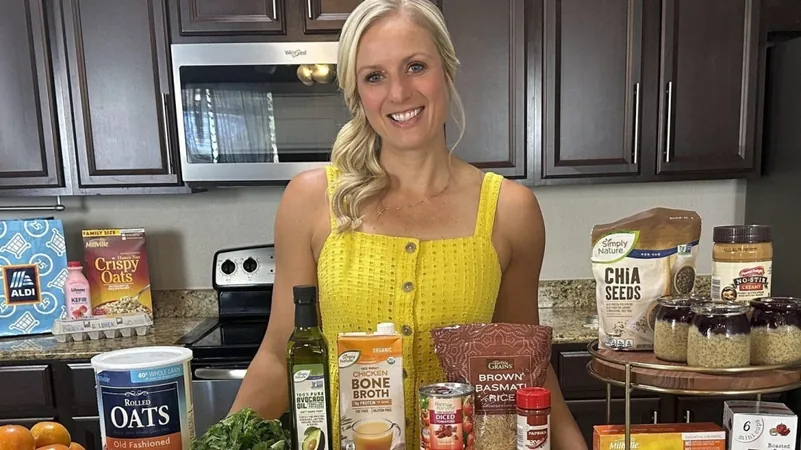
Protein Power: Cutting Back on Meat Without Sacrificing Nutrition! Discover Essential Tips and Irresistible Recipes
2024-09-30
Transitioning to a vegetarian or reduced-meat diet can seem daunting, especially when it comes to ensuring adequate protein intake. Jennifer Anastasiou, who embraced vegetarianism after discovering the environmental impact of livestock farming, once shared her initial concerns about protein. Growing up in a meat-centric Irish-Catholic family in Philadelphia, she found the shift challenging but ultimately rewarding.
For many individuals contemplating a plant-based lifestyle—whether for health, ethical, or environmental reasons—there's often apprehension about how to substitute for the protein typically derived from meat. Surprisingly, livestock contributes nearly half of the agricultural emissions exacerbating climate change, making it even more pressing to consider alternatives.
To tackle the protein puzzle, dietitian Jenna Braddock recommends an approach called "protein stacking." This involves enhancing regular meals by incorporating protein-rich ingredients like nuts, whole grains, or legumes. According to Braddock, the amount of protein required can vary significantly based on individual goals, with recommended values ranging from 1.2 to two grams of protein per kilogram of body weight.
Braddock emphasizes that relying solely on one plant-based protein source can be inefficient or excessive in calories. Instead, she suggests stocking up on versatile foods such as lentils, which pack nine grams of protein per half cup, making them perfect for tacos, salads, or standalone sides. Frozen edamame and tempeh are also excellent protein sources, with tempeh offering a substantial 18 grams in a single serving.
The often-overlooked hemp hearts provide a delightful texture, bursting with fiber and approximately three grams of protein per tablespoon. A simple snack idea that Braddock loves is yogurt topped with fresh fruit and a splash of peanut butter. Surprisingly, peanuts deliver a robust eight grams of protein per quarter cup, making them an affordable and nutritious choice. Other economical options include seeds like pumpkin, sunflower, and chia, as well as quinoa, which is technically a seed but commonly mistaken for a grain.
For those who may not enjoy the texture of beans or tofu, blending these ingredients into soups or dips is a fantastic way to enjoy their benefits. Exploring local restaurants that serve expertly prepared tofu can also enhance the experience, giving you a favorable impression that you can replicate at home.
Braddock emphasizes that transitioning to a more plant-based diet is a journey, one that enhances cooking skills, knowledge, and culinary confidence over time. To inspire you further, here are two high-protein recipes from Braddock’s book, "The High-Protein Vegan Cookbook for Athletes."
Toasted Pumpkin Seed Dip
**Serves:** 4 **Time:** 30 minutes **Ingredients:** - 1 cup hulled pepitas (pumpkin seeds) - 3 plum tomatoes - 1 small red onion, finely chopped - 4 cloves roasted garlic - ¼ cup finely chopped cilantro - ½ habanero chile, stemmed, seeded, and chopped (optional) - 1 tablespoon chipotle chile en adobo, minced - Juice of 1 lime - Juice of ½ orange - 1 teaspoon ground cinnamon *Directions:* 1. In a skillet, lightly toast pepitas over medium-low heat until they pop (about five minutes). Blend into a smooth paste. 2. Roast tomatoes under the broiler until blackened and soft (about 6 minutes each side), then chop finely. 3. In a bowl, combine the seed paste, tomatoes, onion, garlic, cilantro, chipotle, and habanero. Add lime juice, orange juice, and cinnamon, then season with salt. Serve with corn tortillas or crisp veggies.
Quinoa Pilaf with Asparagus
**Serves:** 4 **Time:** 40 minutes **Ingredients:** - 2 cups red quinoa - 4 ½ cups water - ½ teaspoon salt - 1 bunch thin asparagus, roughly chopped - 2 tablespoons extra-virgin olive oil - 1 teaspoon ground cumin - Juice and zest of 1 lemon - ½ cup pine nuts, lightly toasted - 1 small red onion, finely chopped - ½ small bunch fresh basil, chopped - 2 sprigs fresh thyme, chopped *Directions:* 1. Rinse quinoa under cold water until it runs clear. Boil in a saucepan with water and salt, then simmer until tender (about 20 minutes). 2. Combine quinoa and asparagus, cover, and let sit for 5 minutes. Fluff with a fork and mix in olive oil, cumin, lemon juice, and zest. Season with salt and pepper. 3. Just before serving, add pine nuts, red onion, basil, and thyme.
By exploring these recipes and tips, you'll enjoy a delicious journey towards a more plant-based lifestyle without sacrificing your protein needs. The best part? Your taste buds will thank you!









 Brasil (PT)
Brasil (PT)
 Canada (EN)
Canada (EN)
 Chile (ES)
Chile (ES)
 España (ES)
España (ES)
 France (FR)
France (FR)
 Hong Kong (EN)
Hong Kong (EN)
 Italia (IT)
Italia (IT)
 日本 (JA)
日本 (JA)
 Magyarország (HU)
Magyarország (HU)
 Norge (NO)
Norge (NO)
 Polska (PL)
Polska (PL)
 Schweiz (DE)
Schweiz (DE)
 Singapore (EN)
Singapore (EN)
 Sverige (SV)
Sverige (SV)
 Suomi (FI)
Suomi (FI)
 Türkiye (TR)
Türkiye (TR)